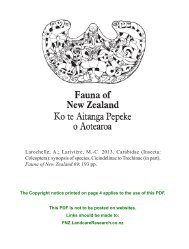PDF File, 693.8 KB - Landcare Research
PDF File, 693.8 KB - Landcare Research
PDF File, 693.8 KB - Landcare Research
Create successful ePaper yourself
Turn your PDF publications into a flip-book with our unique Google optimized e-Paper software.
What’s New In Biological Control of Weeds Issue 48 May 2009<br />
A Stitch in Time?<br />
We have been making some headway<br />
over the last 12 months in the uphill<br />
battle against Chilean needle grass<br />
(Nassella neesiana) in Australia and<br />
New Zealand. During this time a new<br />
infestation of this damaging grass was<br />
found in North Canterbury, confi rming<br />
fears that despite comprehensive<br />
measures to contain it, it was only a<br />
matter of time before the weed became<br />
more widespread, and increasing the<br />
urgency to fi nd better control methods.<br />
Through great perseverance David<br />
McLaren (Department of Primary<br />
Industries, Australia) has fi nally secured<br />
permission to import into Argentina the<br />
grass species we need to include in host<br />
range testing. This means that they can<br />
now be tested by Freda Anderson and<br />
her team of assistants (CERZOS-UNS) for<br />
their susceptibility to the most promising<br />
potential agent, a rust fungus called<br />
Uromyces pencanus. Unfortunately, they<br />
will need to do this testing in a plant<br />
containment facility at Castelar, a town<br />
near Buenos Aires, rather than in their<br />
own glasshouse at Bahía Blanca. Still, for<br />
a while there it looked as though host<br />
range testing would have to be done<br />
outside of Argentina. “While there will be<br />
lots of logistical diffi culties with having to<br />
move ourselves and our equipment 700<br />
km north, it is still a much better option<br />
than shifting the testing to South Africa<br />
or the UK!” observed Freda.<br />
Further good news was received in<br />
January: David’s application to the<br />
Australian Government for a further 12<br />
months of funding, for the 2009 calendar<br />
year, was successful. Due to the delays<br />
in getting the seed to Freda she was<br />
unlikely to be able to complete the host<br />
range testing by the end of 2009, but<br />
fortunately, New Zealand was able to “step<br />
into the breach”. Freda was thrilled to hear<br />
that funding pledged by the National<br />
Biocontrol Collective for the 2009/10<br />
fi nancial year will run until the end of June<br />
2010. “I was having sleepless nights about<br />
getting everything fi nished between<br />
June (when the fi rst test plants should be<br />
ready for inoculation) and December,” said<br />
Freda, “so it is a huge relief to know we<br />
have a few more months up our sleeves.”<br />
New Zealand funding also allowed Jane<br />
Barton to visit Freda again in February<br />
to help with the project. On this trip<br />
Jane carried with her a very precious<br />
parcel: Chilean needle grass seeds from<br />
Marlborough and Auckland. Freda had<br />
found previously that the isolate of<br />
Uromyces pencanus that worked best<br />
against Australian Chilean needle grass<br />
did not attack populations from Auckland<br />
or the Hawke’s Bay, but she had been<br />
unable to test it against material from<br />
Marlborough populations, due to the<br />
diffi culties in getting seed into Argentina.<br />
“I can now get on with that task,” said<br />
Freda “and we are also ‘bulking up’ two<br />
other rust strains to test against New<br />
Zealand plant material.” Jane delivered<br />
the seed to Dr Eduardo Botto, a new and<br />
very helpful collaborator who works at<br />
the quarantine facility in Castelar.<br />
While work with Uromyces pencanus<br />
has been accelerating, the second<br />
most promising candidate, the rust<br />
Puccinia graminella, has been extremely<br />
uncooperative. A particularly hot and dry<br />
summer was followed by an unusually<br />
cold winter and this seems to have led<br />
to the local extinction of P. graminella<br />
at the only fi eld site within striking<br />
distance of Bahía Blanca; other sites are<br />
hundreds of kilometres north. This rust<br />
mostly produces a spore stage known as<br />
aeciospores, which do not store very well.<br />
Consequently, Freda has run out of spores<br />
to use for experiments and is unable to do<br />
any further work on this organism until it<br />
can be re-collected from the fi eld. At least<br />
this will allow Freda to concentrate solely<br />
on U. pencanus for a while, and for once<br />
there appear to be no further obstacles to<br />
the completion of host range testing of<br />
that fungus. Touch wood!!!<br />
Jane Barton is a contractor to <strong>Landcare</strong><br />
<strong>Research</strong>.<br />
Chilean needle grass seed on a quad bike that has gone through infested paddocks in the Blind River<br />
area of Marlborough.<br />
Marlborough District Council<br />
3
















